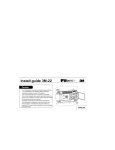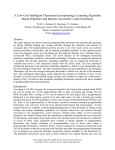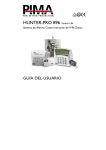Download TED 5000 FOOTPRINTS User Manual
Transcript
Page 1 TED 5000 FOOTPRINTS User Manual TABLE OF CONTENTS 1.Live Dashboard Page 2 2.Setup Page 2 2.1. System Settings Wizard Page 2 2.2. Utility Setings Wizard Page 10 2.3. Advanced Functions Page 17 2.4 3rd Party Posting Page 19 2.5 TED Advisor Page 20 3. Data Export 4. Print / Enhanced Mode Page 21 Page 22 5. History Page 23 6. Graphs Page 24 7. Load Profile Page 29 8. Net Metering- Solar/Wind Page 32 9. Help File Page 33 Appendix: A v.3.3.1 Connecting TED5000 Directly To a Computer www.theenergydetective.com Page 34 Page 32 When you first open Footprints5000, you will see the Live Dashboard Screen. None of the data will be populated until you complete the Setup procedures described below. To get your system up and running, please follow these steps completely. Under the EDIT tab, press System Setup Wizard as shown below to begin the Setup process. © Copyright 2008-2012 Energy, Inc. All rights reserved Page 3 Next you will see the Welcome screen. You can move from screen-to-screen by pressing the next/previous button or by selecting the specific TAB you want. Let’s go through the screens one by one: Please note that for most users the optimum settings are already set by default. Other than the Product IDs, we highly recommend that you leave the settings as-is until you fully understand how it works and exactly what it is you want to change. The System can be modified at any time simply by going through this System Setup Wizard. Network Settings tab If you are connected to a standard router, you should not need to change the default settings at all. The only change you should make is to UNCHECK the box indicated below. This will make the IP address static as assigned by your router. All of the information should auto-fill. Do not change any of these numbers. Uncheck this box v.3.3.1 www.theenergydetective.com If you are connecting directly to your computer (not recommended) see Appendix A. Page 54 Time and Date If you are connected to the Internet (router or computer), TED will automatically retrieve the time. If not, uncheck the box and enter the time and date. Once set, the Gateway will keep track of time, even during a power failure. System Layout Here is where we tell TED about your installed system. If you have typical installation with one MTU, one Gateway and one Display, then you won’t need to change anything. If you have more than one MTU (Dual Panel or Solar/ Wind Package) then change the quantities as required. If you installed your MTU(s) using only the Black and White wires (as we suggest), you will set the Voltage Display as shown. If you own a Radio Thermostat thermostat (available at Home Depot), you will be able to adjust your thermostat settings via TED. If you do not own a RadioThermostat, simply leave as ‘0.’ © Copyright 2008-2012 Energy, Inc. All rights reserved Page 5 Product IDs (Extremely important) Footprints will automatically read the Gateway ID from the Gateway. The IDs for the MTU and Display are initially set to 00 00 00. The Gateway will only communicate with MTUs and Displays with IDs that you list under this tab. This is for security reasons. You don’t want to be displaying your neighbor’s energy use. Type in the ID(s) from MTU(s) in format 10 12 34 (they are located on the sticker on the MTU). Next you will need to get the ID of the Display(s). Press and hold the Display Button for 30 seconds and the ID will be shown. Type in the ID(s) from the Display(s) in format 30 12 34. The Description is not required, but you may fill in something meaningful if you have more than one. For example, “Upstairs Display” and “Downstairs Display” After filling in this information, refer to your RadioThermostat Instruction Manual to sync your RadioThermostat with TED. Operational Settings These settings control how often information is updated in the system. It is recommended that these not be changed. v.3.3.1 www.theenergydetective.com Page 76 Display Setting Your Display is very flexible; you can adjust the backlight, sleep and scroll settings, you can also select which screens to display. You can check one, any, or all of them depending on which information is important to you. © Copyright 2008-2012 Energy, Inc. All rights reserved Page 7 Footprints Settings You can adjust the ranges displayed within the Footprints program. Dashboard Settings: The Max Value is the maximum amount shown on any graphs. If you have a small, energy-efficient home and family, you may only see a maximum real time use of 5kW. Change the “Real Time kW Usage” setting to “5” and the maximum on the dial will be 5kW instead of 12kW. If you have a large home, you may need to change it to 40kW to keep the needle from pegging. Any of the scales can be changed temporarily from the Dashboard by pressing the + - tabs. The Scale Value adjusts how much the scale changes with each press of the + - key. This will help you determine what the permanent settings should be in Footprints Settings. Graph Settings: You can adjust which items will be graphed and in which color. To show Multiple MTUs you can choose to show all the values or just the total. For Solar installations only, make this number a NEGATIVE number equal to the size of your PV system. In other words, if you have a 7kW system, you should make this a -7. Input your Zip Code for weather display. Weather is updated every hour. For installations outside of the continental US, you may input your latitude/longitude for weather. v.3.3.1 Check this box to see multiple MTUs on the Dashboard www.theenergydetective.com Check this box to show Power Factor and kVA on Dashboard. (If you’re not sure what these are, don’t bother checking the box...it’s for the electrical-guys.) Page 98 Write to Device Like any software program, you need to save the changes you made. Changes will be applied when you click the Update button. Backup Settings Before updating changes, you can save the previous settings to a file on your PC. (Recommended) Restore Settings You can restore settings that you previously saved to a file on your PC. The restored settings will be applied when the Update button is selected. Update You will use this function any time you make a change to your TED 5000 system. This will update the changes you make and save them to the Gateway. Press UPDATE. After pressing UPDATE, the progress bar will indicate that it is writing the data to the Gateway. © Copyright 2008-2012 Energy, Inc. All rights reserved Page 9 Wait for the progress bar to read 100%, then you press finish. Footprints will then refresh your browser and the system will begin operation with your new settings. You may make changes to the Settings at any time. v.3.3.1 www.theenergydetective.com Page 11 10 Utility Settings Wizard These settings affect the rate calculations of your TED 5000 system. It would be most helpful to have your most recent electric bill handy for this. TED 5000 automatically resets the billing cycle based on the Meter Read Date. This date may fluctuate from billto-bill by a couple of days (depending on weekends, etc), but it will generally be pretty reliable. Do not change the Meter Read Date if your bill comes in and the date is off by one or two days, because your next month bill will likely adjust for it. Select 1 if your utility does not have tariffs for different seasons of the year. Select 2 if you have SUMMER and WINTER rates. Select 3 if you have THREE seasons. Select 4 if you have WINTER, SPRING, SUMMER, and FALL rates Select NEXT after making your selection © Copyright 2008-2012 Energy, Inc. All rights reserved Page 11 Choose your rate plan type here FLAT - a fixed price per kWh. (i.e. $0.1152) TIERED - Your utility bill uses a tiered formula. (i.e. $.xxxx for 1st xxx kWh and $.xxxx for 2nd xxx kWh and $.xxxx for 3rd kWh and so on.) TIME OF USE - Your utility has different rates during different times of the day. (i.e. From 8-10a.m. is $.xxxx kWh, from 1-6pm is $.xxxx kWh.) TIERED WITHIN A TIME OF USE - Choose this if your utility bill is based on a Tiered system within a Time of Use system. (i.e. $0.xxxx for 1st xxx kWh from 8-10a.m., $0.xxxx per kWh for 2nd kWh from 8-10a.m., etc.) Select NEXT after making your selection The Rate Plan Type selected will determine what the next screen will show v.3.3.1 www.theenergydetective.com Screen Samples showing FLAT RATE with SEASONS Note: The format used for CENTS per Kilowatt Hour is $0.xxxxx, where “x” is the actual cents charged. Think about it...how do you write thirteen cents? Answer: $0.13000 These are the screens that you would see if you were to select 1 Season, 2 Seasons, 3 Seasons, and 4 Seasons. © Copyright 2008-2012 Energy, Inc. All rights reserved Page 13 12 Screen Sample showing TIERED RATE with 2 SEASONS If you entered a number of Seasons other than “1”, you will enter the Tiers for each Season. Upon entry of the kWh break point of the 1st Tier, the second break point will automatically appear. You will then enter the kWh break point of the 2nd Tier. The beginning of the 3rd Tier will automatically appear. After you’ve entered the next-to-last kWh break point, TED will automatically show the beginning of the ‘balance’ of kWh. v.3.3.1 www.theenergydetective.com Page 13 Page 15 14 Screen Samples showing TIME OF USE RATES with SEASONS Most utilities consider weekends and holidays OFF PEAK. Check here if that is NOT the case. Notice that each rate can be in the AM and the PM. If a rate occurs only once in the day, leave the other (AM or PM) at the default of 12:00 - 12:00. If you have entered multiple Seasons, you will need to input the TOU periods for all seasons as well. Select NEXT when completed Enter the corresponding rates. If your utility has a 6th digit, just round it up/down. Select NEXT when completed © Copyright 2008-2012 Energy, Inc. All rights reserved Page 15 Demand Charges Most Utilities do not have residential Demand Charges, but in the event you do, here is the screen you would follow to input the charges. This is a charge billed by some, but not all utilities from time to time to recover their costs for extraordinary fuel prices. For example, neighborhood street lighting costs, or any other recurring costs the Utility may pass on to the consumer. If more than one fixed fee applies, enter the sum of all fees. Some utilities, in addition to a charge per kWh, have a minimum charge for electricity. This is typically a flat-fee. Charged as a percentage calculation of the entire bill. If you have multiple items on your bill that are calculated as a percentge, you can add them all together and enter them here. Select NEXT when completed v.3.3.1 www.theenergydetective.com Page 17 16 Write to Device Like any software program, you need to save the changes you made. Changes will be applied when you click the Update button. Backup Settings Before updating changes, you can save the previous settings to a file on your PC. (Recommended) Restore Settings You can restore settings that you previously saved to a file on your PC. The restored settings will be applied when the Update button is selected. Update You will use this function every time you make a change to your TED 5000 system. This will update the changes you make and save them to the Gateway. Press UPDATE. Wait on the progress bar to reach 100%, and then press FINISH © Copyright 2008-2012 Energy, Inc. All rights reserved Page 17 Advanced Functions Restart TED5000 Selecting “Restart TED5000” accomplishes the same thing as unplugging your Gateway. It is not something you will likely find yourself needing to do. It simply eliminates the need to physically unplug the Gateway. Firmware Update You can update your Footprints firmware using the instructions below, but it is HIGHLY recommended that any firmware updates are done following the exact instructions at this link: http://www.theenergydetective.com/upgrade (see note above on Firmware Update) There will be occasions when TED or your utility may have an update for your firmware. It could be an update for your Display, the MTU, or the Gateway. It may be a rate change, software modification, or a new feature. There are several ways in which you can receive the update: by link in an email, a direct download from the TED website, or from your Utility’s website. It will be your option to install the update. Once you have downloaded the update to your computer, you will need to select the “Update Firmware” feature on TED 5000 shown below. Click the Browse button and locate the firmware you are wanting to update. Once you have located and selected the file, click UPDATE FIRMWARE. The process is totally automatic at this point. Depending on the size of the update, this process could take from one to 30 minutes. v.3.3.1 www.theenergydetective.com Page 19 18 Reset Totals to Zero Select this function to reset all of your totals to zero. This is a non-recoverable act, so you may want to consider Exporting your data prior to executing this function. Erase History Select this function to erase your entire history. This is a non-recoverable act, so you may want to consider Exporting your data prior to executing this function. Reset to Factory Default Select this function to reset all the data within TED. The will clear ALL history, charts, graphs, and all operational variables (time, date, rates, meter date, etc.) This is a non-recoverable act, so you may want to consider Exporting your data prior to executing this function. Adjusting MTU Calibration Your TED comes calibrated from the factory. The default multiplier is 1:1. If, after a 2-3 MONTH period, you feel TED is not matching your utility meter exactly, you can modify this multiplier to make TED more closely match your utility meter. Most installations do NOT require any changes to the default. © Copyright 2008-2012 Energy, Inc. All rights reserved Page 19 3rd Party Posting If you wish to send your TED-data to an outside source (like a university, a neighborhood/ community, a solar-company, a utility, or any other entity that is aggregating the data), this is a user-friendly way to do so. Just click the “Activate Energy Posting” button and follow the onscreen instructions. Note: You may only post to one source at a time. v.3.3.1 www.theenergydetective.com Page 21 20 TED Advisor TED Advisor is a real-time energy notification system. TED Advisor sends immediate notification, locally and remotely, via email and/or text message to let you know that a user-defined parameter has been reached. You may need to call your Internet Service Provider (ISP) to obtain some of the details below. Check the appropriate box for any parameter for which you would like notification. © Copyright 2008-2012 Energy, Inc. All rights reserved Page 21 EXPORT Tab Data Export Feature Since TED 5000 stores 60 minutes of second-data, 48 hours of minute-data, 90 days of hourly data, 24 months of daily data, and 10 years of monthly data in separate files, they can be exported independent of each other. Simply select the data you would like to export to analyze, and follow the on-screen instructions. If you have multiple MTUs or a SOLAR /WIND installation, you can output the data for each for analysis. v.3.3.1 www.theenergydetective.com Page 23 22 FILE Tab Print / Enhanced Mode / Exit Print This action will allow you to print any of the screens as you see them on TED 5000, i.e. the Dashboard, Historical Charts, Graphs or Load Profiles. Activate Enhanced Mode Activating Enhanced Mode will temporarily change the sample/transmission interval of your power and voltage readings to reflect the settings you have in SYSTEM SETUP. You might use this feature to do some temporary diagnostics where you need to see very fast response times beyond what you would routinely want to see. © Copyright 2008-2012 Energy, Inc. All rights reserved Page 23 HISTORY Tab Use this History Chart to compare your usage with prior time periods. The data auto-populates. Compare Hours, Days, and Months. To see historical data for separate MTUs, simply click the desired MTU as shown below. v.3.3.1 www.theenergydetective.com Page 25 24 GRAPHING Tab TED 5000 stores data internally in its Gateway. This data can be retrieved at any time and graphed displayed in graphic form. The data available for viewing is: SECONDS - one hour of second-data in increments from Live (real-time) recording, 30-seconds, or 1, 2, 5, 15, 30 and 60 minutes. MINUTES - 48 hours of minute-data may be displayed in increments from 30 minutes; 1, 2, 4, 12, 24, 36, to 48 hours. HOUR - 90 days of hourly data are stored. Historical Hourly Data is viewable for any selected date-range in increments of 7-day periods. Specific Hourly Data can be viewed in kWh, Voltage, or Dollars. DAY - 2 years of Daily data are stored. Daily Data is viewable for any selected range for the prior 2 years in 90-day periods. Data viewable is: kWh, Dollars, Minimum/Maximum Voltage, Minimum/ Maximum Cost, Minimum/Maximum Power (kW). MONTH - 10 years of Monthly data are stored. Data viewable is: kWh, Dollars, Minimum/Maximum Voltage, Minimum/Maximum Cost, Minimum/Maximum Power (kW). Sample - SECONDS graph of KW - scale selected is 30 seconds Line colors are user-selectable in System Setup. If more than 1 MTU is installed, or Solar/Wind package installed, each MTU is displayed layered or independently. © Copyright 2008-2012 Energy, Inc. All rights reserved Page 25 Sample - MINUTE graph of KW- scale selected is 12 Hours Looking at this graph, you can immediately see when the HVAC is on, when activity begins in the home, hotwater heater coming on, etc. Sample - HOUR graph of kWh - range selected is 2 days Hovering over any point on any graph will give the specific detail of that moment in time. This is a 2-day view showing the kWh used each hour of the day. v.3.3.1 www.theenergydetective.com Page 27 26 Sample - HOUR graph of Dollars spent - range selected is 2 Days This is a 2-day view showing the Dollars spent each hour of the day. Hover over any point to see the specific usage detail. Sample - HOUR graph of Minimum and Maximum Voltage - range selected is 2 Days This is a 2-day view showing the mimimum and maximum voltage delivered to your home over a 2day period. As with all graphs, hover over any point on the graph to see the specific detail. © Copyright 2008-2012 Energy, Inc. All rights reserved Page 27 Sample - DAY graph of kWh usage - range selected is 7 Days This is a 7-day view showing the kWh used each day. See what days most electricity is used. What took place those days? Sample - DAY graph of Minimum and Maximum kW usage - range selected is 7 Days This is a 7-day view showing the minimum and maximum kW used each day. Why so high?! Why so low?! How low can you go? v.3.3.1 www.theenergydetective.com Page 29 28 Sample - DAY graph of Minimum and Maximum of Money Spent - range 7 days This is a 7-day view showing the most and least amount of money spent each day. Now it’s meaningful! The money counts. Sample - DAY graph of Minimum and Maximum of Voltage - range 11 days This is a 11-day view showing the most and least amount of voltage each day coming from the utility. The Solar/Wind package will show the generation, grid-supplied power, and the net. © Copyright 2008-2012 Energy, Inc. All rights reserved Page 29 Load Profile TED Footprints provides the ability to monitor simple changes in kW usage to create Load Profile Events. The concept of Load Profiling is based on TED’s recognition of a ‘footprint’ created when a load is turned on or off. Theoretically, any electrical load may be profiled, however, the more common the load (i.e. 60w light), the more likely a false-positive will be registered. In other words, you may turn on your computer or TV, or any 60w load, and Footprints would not be able to discern which was turned on - the light, the computer, or the TV. That being said, major loads (water heater, HVAC, pool pump, hot tub) are more easily profiled because they are less likely to have similar loads. Please note that the Load Profile feature is only intended to indicate when an appliance might have possibly been turned on or off, and that many factors may cause an event to be incorrectly registered. The following is an example of Load Profiling a Hot Water Heater A hot water heater turning on might register a 4.6kW increase over a few seconds. TED Footprints will watch for a 4.6 kW increase and register an event signaling that the device has been turned on. Once a 4.6kW decrease is measured, Footprints will log an additional event signaling that the device has been turned off. To Add, Edit or Delete a Load Profile Appliance. select “Load Profile Wizard” under EDIT. TED Footprints will track up to five electrical devices. To ADD a device The wizard will prompt you for the name of the device. Appliance Names must be unique. If you attempt to add a second appliance with the same name as an appliance that already exists, you will overwrite the settings of the original appliance. MTU# allows you to select which MTU the load may be measured by (in the instance of dual electric panels, or solar/wind generation). Generally, there will only be one MTU. Start Stages - Some electrical devices have multiplestart stages (i.e. some HVAC systems). Stop Stages - As with Start Stages, some devices power down in stages. Percent Error - This figure can be adjusted as the user wishes. It will help TED Footprints to avoid falsepositive readings. v.3.3.1 www.theenergydetective.com Page 31 30 For best results, it is best to turn off as many appliances as possible prior to setting up Load Profiles; be certain that the electrical load of your home is stable, and not fluctuating. When the Learn button is pressed, Footprints will monitor for the next kW increase. The device being profiled may need to be on for over 30 seconds to be detected. Once a kW change is detected, the value will be automatically entered into Stage 1 field. Alternatively, you may manually input the value if preferred. Current Readings: Live - is the actual usage of your home at the moment. Event - is the last change TED noted in the power. You may press the BACK button at any time to go back to a prior screen. When Load Profile is complete, press the SAVE button to complete the process. To EDIT or DELETE your Load Profile settings, select the Load Profile Wizard under the EDIT, and select the device you wish to modify. Modifications to a Load Profile are performed as stated in the ‘ADD’ section detailed above. © Copyright 2008-2012 Energy, Inc. All rights reserved Page 31 Click the drop-down to view other Loads that have been profiled v.3.3.1 You may manually toggle a device on/off by clicking here. www.theenergydetective.com Page 33 32 Solar/Wind Generation If you are generating power (solar/wind, or auxiliary generator), TED is designed to record your Generation, Consumption, and record the Net of the two as well. At any time, you can see each independently simply by checking the appropriate tab on the Live Dashboard (MTU1, MTU2, NET). This section is to be completed only after the physical installation of the MTU(s) and CT(s) have been completed. In a Solar configuration where the inverter ties into the house panel, MTU 1 should be set to ADJUSTED LOAD. (MTU 1 should be the MTU in the main electrical panel). If the inverter ties in up-stream between the meter and the panel, then MTU 1 should be shown as “LOAD.” Set the remaining MTU which is connected to your Solar/Wind inverter to “Generation.” Depending on the TED system purchased, your system came with two MTUs or more (a TED system can have up to 4 MTUs). One/some MTU(s) will be measuring your Consumption (Load), and the second(other) MTU will be measuring your Production (Generation). Footprints will record each of these, and also present the NET of your Production/Consumption. Under the EDIT tab, select System Setup Wizard - Select the tab System Layout - Under “How Many MTUs?”, click the drop-down and select how many you have installed. - Under “Multiple MTU Configuration,” select “SOLAR” if you have installed a Generating system. Please also refer to Page 7 for some critical settings for Footprints (which will help set up your graphing of solar activity). Only after you have completed the Setup of your system will the changes be noted on the Live Dashboard. By selecting “NET”, you will see a combined view of both/all of your MTUs...showing you a positive number if your consumption is greater than your generation, or a negative view if you are generating more electricity than you are consuming (sending electricity back to the grid). You can view MTU1, MTU2, (MTU3 & MTU4 - if you have that many installed) all independently simply by selecting the appropriate MTU. © Copyright 2008-2012 Energy, Inc. All rights reserved Page 33 HELP Tab Selecting any of the items shown under the HELP tab will open a link to download a file. You can choose to either view the files on your browser window, or you can save them to your computer. TED 5000 Statistics Page This will open up a diagnostics screen. The most meaningful items (to the user) on the screen are the “MTU Rec” and “MTU Skp” shown below. These indicate Received data-packets and Skipped datapackets. If the Skipped is 20% or less than the Received, your system is in great shape. (divide MTU Skp by MTU Rec). In the example below: 30 divided by 783 = 0.038 (or 3.8%) If your MTU Skp ratio is higher than 20%, we would suggest you visit the following link: http://www.theenergydetective.com/PLC v.3.3.1 www.theenergydetective.com Page 35 34 APPENDIX A Connecting TED 5000 Gateway Directly to a Computer Note: It is highly recommended that you connect your Gateway directly to your router, and not your computer. • Installation and setup is simplified. • Energy information can be viewed by any device connected on your home network. • Time is automatically synchronized. • Up to the minute weather information is available. If you do not have a router, we highly recommend that you purchase one. To connect your Gateway directly to your computer, you will most likely need to change the network settings on your computer. Please carefully follow these steps: 1. Plug the Gateway into a 120V outlet. 2. Connect your PC to the Gateway with the included Ethernet Patch Cable. 2.1. If you need a longer cable, any CAT V cable with RJ45 jacks may be used. 2.2. A cross-over cable can be used to direct-connect to the computer, but it is not necessary. The Gateway automatically senses the cable configuration. 3. Open your web browser (Internet Explorer, Firefox, Chrome, etc.) 3.1. In the address bar type in: http://192.168.7.2/Footprints.html 3.2. FootPrints 5000 Dashboard should load (Note: could take up to 1 ½ minutes to load) 4. If you get a “Cannot Open Webpage” or “File Not Found” error on your browser, then you will need to change the IP of your PC. 4.1. Go to Control Panel/Network and Sharing Center (accessed from Start Menu) 4.2. Click on Manage Network Connections. © Copyright 2008-2012 Energy, Inc. All rights reserved Page 35 4.3. Click on Local Area Connection 4.4. Click on Properties v.3.3.1 www.theenergydetective.com Page 37 36 4.5. Highlight Internet Protocol Version 4 (TCP/IPv4). Click on “Properties” 4.6. Click “Use the following IP address” and fill in as shown: 4.6.1. IP Address 192.168.7.1 4.6.2. Subnet mask: 255.255.255.0 4.6.3. Default Gateway:192.168.7.1 © Copyright 2008-2012 Energy, Inc. All rights reserved Page 37 4.7. Click OK 4.8. Restart your browser and type: http://192.168.7.2/Footprints.html into the address bar. 4.9. Footprints 5000 Dashboard should be displayed 4.9.1. Read and follow Footprints 5000 Help File. 4.9.2. If Footprints 5000 does not come up, please contact your network administrator, IT department or trained computer professional. TED (Energy, Inc.) can not help you troubleshoot network issues. v.3.3.1 www.theenergydetective.com Page 39 38 TED 5000 FOOTPRINTS User Manual Contenido 1.Tablero Vivo Página 2 2.Configuración Página 2 2.1.Ayudante de configurar el sistema Página 2 2.2. Ayudante de configurar la utilidad Página 10 2.3. Actualizar Firmware Página 17 2.4 Funciones especiales 3. Exportacion de los datos Página 18 Página 22 4. Impresión/modo mejorado página Página 23 5. Historia Página 24 6. Gráficos Página 25 7.Haciendo Perfil de carga Página 30 8.Medición total – Solar/de Viento página Página 33 Apéndice: A. Conectar TED5000 directamente a una computadora Página 34 © Copyright 2008-2012 Energy, Inc. All rights reserved Page 39 Al iniciar Footprints5000, se verá la pantalla del Live Dashboard (Tablero Vivo). Ningunos de los datos se actualizará hasta que completas el procedimiento descrito abajo. F11 para cambiar entre Windows y modo de pantalla completa. Para iniciar y configurar el sistema, por favor sigas estos pasos completamente. Bajo la pestaña EDIT (editar), haga clic en “System Setup Wizard” (ayundante de configurar el sistema) como es mostrado para iniciar el proceso de configuración. v.3.3.1 www.theenergydetective.com Page 41 40 Después aparece la pantalla de bienvenida. Se puede cambiar entre pantallas haciendo clic en los botones “next/ previous” (siguiente/atrás) o seleccionando la pestaña específica deseada. Pasemos por las pantallas una por una: Tome nota que las configuraciones ya están en los puestos óptimos para la mayoría de los usuarios. Además de las identificaciones de producto, le recomendamos que deje las configuraciones tales como son hasta que entienda totalmente como funciona y exactamente lo que quiere cambiar. Pestaña de “Network Settings” (Configuraciones de la red) Si está conectado a un router estándar, no se necesita cambiar esto. Si está conectado directamente a su computadora (no se le recomienda) vea al Apéndice A. © Copyright 2008-2012 Energy, Inc. All rights reserved Page 41 “Time and Date” (Hora y Fecha) Si está conectado a Internet (por router o computadora), TED ajustará la hora automáticamente. Si no, deseleccione esta caja y digite la hora y la fecha. Una vez puestas, el Gateway lleva el tiempo aunque haya una falla de electricidad. “System Layout” (Diseño del sistema) Aquí se le comunica al TED sobre el sistema instalado. Si tiene una instalación típica en una sola UME entonces no hay que cambiar nada. Si tiene más que una UME (paneles duales o paquete Solar/de viento) entonces hay que cambiar las cantidades como sea necesario. Le pedirá que haga una descripción. Por ejemplo, Panel 1 Casa, Panel 2 Garaje. v.3.3.1 www.theenergydetective.com Page 43 42 Product IDs (Identificaciones del producto) (Sumamente importante) Footprints reconoce automáticamente la identificación del Gateway. Inicialmente, las identificaciones para la UME y Pantalla están puestas en 00 00 00. El Gateway sólo se comunica con las UME’s y pantallas con identificaciones que usted define en esta pestaña. Esto es para seguridad. Usted no quiere ver el uso de energía de su vecino. Digite las identificaciones de las UME’s en formato 10 12 34 (están ubicadas en la etiqueta de la UME). Después hay que conseguir la identificación de la(s) pantalla(s). Presione el ‘Display Button’ (botón de pantalla) y manténgalo presionado durante 30 segundos y se mostrará la identificación. Digite la(s) identificación(es) de la(s) pantalla(s) en formato 30 12 34. Operational Settings (configuraciones de operación) Estas configuraciones controlan cuan frecuente se actualizan los datos en el sistema. Se le recomienda que no se las cambie. © Copyright 2008-2012 Energy, Inc. All rights reserved Page 43 Display Setting (Configuración de la Pantalla) Se puede ajustar la luz de la pantalla y configuraciones de dormir y desplazar. Vea al Apéndice C para una explicación detallada. También se puede seleccionar cuales pantallas mostrar. Se puede seleccionar una, varias o todas ellas dependiendo en cuales datos son importantes para usted. v.3.3.1 www.theenergydetective.com Page 45 44 Footprints Settings (Configuraciones de Footprints) Se puede ajustar los rangos mostrados dentro del programa Footprints. Dashboard Settings (Configuraciones del tablero): El valor máximo es la cantidad máxima mostrada en las pantallas gráficas. Si tiene una familia pequeña y una casa pequeña y eficiente puede que sólo vea un máximo uso actual de 5 kilovatios (kW). Cambie la configuración del “Real Time kW Usage” (uso kW actual) a “5” y el máximo en el dial será 5kW en vez de 12kW. Si tiene una casa grande puede que se necesite cambiarlo a 40kW para que la aguja no se pegue. Se puede cambiar cualquiera de las escalas temporalmente por presionar las pestañas +/-. El valor de la escala se ajusta con respeto a los cambios de la escala cada vez que se presione la tecla +/-. Graph Settings (Configuraciones de los gráficos): Se puede ajustar cuales datos salen en los gráficos y en cual color. Misc Settings (Configuraciones variadas): Digite su código postal para ver el tiempo local. Haga clic en “Show Power Factor” (Muestra el factor del poder) y KWA si quiere que estos valores se muestren en el “Dashboard” (tablero). (Si no sabe lo que son, es probable que no quiere mostrarlos) Muestra varias UME’s: Si tiene varias UME’s se puede elegir mostrar todos los valores o sólo la suma. © Copyright 2008-2012 Energy, Inc. All rights reserved Page 45 Write to Device (Escribir al aparato) Como cualquier programa de software, hay que guardar los cambios que ha hecho. Se aplican los cambios al hacer clic en el botón “Update” (actualizar). Backup Settings (Guardar Configuraciones) Antes de actualizar cambios, se puede guardar las configuraciones anteriores a un archivo en su computadora. (Recomendado) Restore Settings (Restaurar Configuraciones) Se puede restaurar las configuraciones que han sido guardadas anteriormente en su computadora. Se aplican las configuraciones restauradas cuando selecciona el botón “Update” (actualizar). Update (Actualizar) Se usa esta función cada vez que hace un cambio al sistema TED5000. Así se actualizan los cambios que Ud. hace y se los guarda al Gateway. Presione UPDATE (Actualiza). Después de presionar UPDATE (Actualiza), la barra del progreso le indica que está escribiendo los datos al Gateway. v.3.3.1 www.theenergydetective.com Page 47 46 Espere que la barra de progreso llegue a 100% y entonces Presione “Finish” (terminar). Entonces Footprints se actualizar el navegador y el sistema operará con las nuevas configuraciones. Se puede hacer cambios a las configuraciones en cualquier momento. © Copyright 2008-2012 Energy, Inc. All rights reserved Page 47 Utility Settings Wizard (Ayudante de las configuraciones de la utilidad) Estas configuraciones afectan las calculaciones de tarifa del sistema TED5000. Es recomendado tener su factura de electricidad más reciente a mano. TED5000 se vuelve a cero automáticamente el ciclo de facturación en la fecha de revisión de medidor de electricidad. Esta fecha puede fluctuar de factura a factura por unos días (dependiendo en fines de semana, etc.), pero es bastante confiable. Le sugerimos que no cambie la fecha de revisión del medidor si le llega la factura de electricidad y la fecha se varia por uno o dos días por que probablemente su próxima factura estará ajustada. Seleccione 1 si su utilidad no tiene tarifas variadas para estaciones diferentes del año. Seleccione 2 si tiene tarifas de verano e invierno Seleccione 3 si tiene tres estaciones Seleccione 4 si tiene invierno, primavera, verano y otoño Seleccione NEXT (siguiente) después de seleccionar v.3.3.1 www.theenergydetective.com Page 49 48 Escoja su tipo de plan de tarifa aquí: FLAT (Fija) – un precio fijo por kWh (kilovatio por hora). (i.e. $0.1152) TIERED (Nivelada) – La factura de utilidad se utiliza una formula nivelada. (i.e. $.xxxx por 1º xxx kWh y $.xxxx por 2º xxx kWh y $.xxxx por 3º kWh y etc.) TIME OF USE (Tiempo de uso) – Su utilidad tiene tarifas diferentes durante varias horas del día. (i.e. Desde 8-10a.m. son $.xxxx kWh, desde 1-6pm son $.xxxx kWh.) TIERED WITHIN A TIME OF USE (Nivelada dentro de un tiempo de uso) – Escoja esto si la factura de utilidad se basa en un sistema nivelado dentro de un sistema de tiempo de uso. (i.e. $0.xxxx por 1º xxx kWh desde 8-10a.m., $0.xxxx por kWh por 2º kWh desde 8-10a.m., etc) Seleccione NEXT (siguiente) después de hacer su selección El tipo de plan de tarifa seleccionado determina la pantalla que sigue © Copyright 2008-2012 Energy, Inc. All rights reserved Page 49 Ejemplos de pantallas mostrando tarifa fija con estaciones Estas son las pantallas que se ve si selecciona 1, 2, 3 o 4 estaciones. v.3.3.1 www.theenergydetective.com Page 51 50 Ejemplo de pantalla mostrando TIERED RATE (tarifa nivelada) con dos estaciones Si digitó una cantidad de estaciones que no sea “1”, hay que introducir los Tiers (niveles) para cada estación. Al digitar el “breakpoint” (punto de cambio) del primer Tier (nivel), el segundo punto de cambio se aparece automáticamente. Ponga el punto de cambio del 2º nivel. El inicio del 3º nivel aparece automáticamente. Después de digitar el penúltimo punto de cambio, TED muestra el inicio del “balance” de kWh automáticamente. © Copyright 2008-2012 Energy, Inc. All rights reserved Page 51 Ejemplos de pantallas mostrando tarifas de tiempo de uso con estaciones La mayoría de utilidades consideran los fines de semana y feriados de tarifa reducida. Haga clic aquí si este NO es el caso. Fíjese que cada tarifa puede estar en el AM y el PM. Si una tarifa sólo ocurre una vez al día, deje el otro (AM o PM) en el puesto original de 12:00 – 12:00 Si ha introducido varias estaciones, se necesita introducir los periodos de TOU (tiempo de uso) para las estaciones también. Seleccione NEXT (siguiente) al completarlo Digite las tarifas correspondientes. Si la utilidad tiene un sexto dígito, redondéelo. Seleccione NEXT (siguiente) al completarlo v.3.3.1 www.theenergydetective.com Page 53 52 Recarga de energía o combustible // ¿Hay un recargo de energía o combustible? Esto es una carga hecha por algunas, pero no todas las utilidades de vez en cuando para recuperar los gastos extraordinarios de combustible. Carga fijas // ¿Se le hace una carga fija por periodo la utilidad? Por ejemplo, gastos de las luces públicas u otros gastos recurrentes que la utilidad le pasa al cliente. Si se aplica más que uno carga fija, digite la suma de todas las cargas. Carga mínima // ¿Se le cobra una carga mínima por periodo su utilidad? Algunas utilidades, además de cargar por kWh, tienen una carga mínima para la electricidad. Típicamente es una carga fija. Impuestos // ¿Se aplican impuestos municipales, del estado o federales a la factura? Cobrado como un porcentaje de la factura entera. Si tiene cargas múltiples de su factura que se calculan en porcentajes, se puede sumar todas y digitarlas aquí. Seleccione NEXT (siguiente) al completarlo © Copyright 2008-2012 Energy, Inc. All rights reserved Page 53 Write to Device (Escribir al aparato) Como cualquier programa de software, hay que guardar los cambios que ha hecho. Se aplican los cambios al hacer clic en el botón “Update” (actualizar). Backup Settings (Guardar Configuraciones) Antes de actualizar cambios, se puede guardar las configuraciones anteriores a un archive en su computadora. (Recomendado) Restore Settings (Restaurar Configuraciones) Se puede restaurar las configuraciones que han sido guardadas anteriormente en su computadora. Se aplican las configuraciones restauradas cuando selecciona el botón “Update” (actualizar). Update (Actualizar) Se usa esta función cada vez que hace un cambio al sistema TED5000. Así se actualizan los cambios que Ud. hace y se los guarda al Gateway. Presione UPDATE (Actualizar) Presione Espere que la barra de progreso llegue a 100% y entonces presione FINISH (terminar) v.3.3.1 www.theenergydetective.com Page 55 54 Actualizar Firmware Habrá ocasiones en las cuales TED o su utilidad tendrán actualizaciones para su firmware. Puede ser una actualización para la pantalla, la UME o el Gateway. Puede ser un cambio de tarifa, modificación de software, o una nueva función. Hay varias maneras de recibir las actualizaciones: por un vínculo en un correo electrónico, una descarga directa de la página de web de TED, o de la página de su utilidad. Usted tendrá la opción de instalar la actualización. Después de cargar la actualización en su computadora, hay que iniciar la función “Update Firmware” (actualizar firmware) en TED mostrado abajo. Haga clic en el botón Browse (Buscar) y ubique el firmware que quiere actualizar. Después de ubicar y seleccionar el archivo haga clic en “Update Firmware” (actualizar firmware). Desde este punto en adelante el proceso es automático. Dependiendo de la complejidad de la actualización, el proceso puede dura desde 10 segundos hasta 10 minutos. © Copyright 2008-2012 Energy, Inc. All rights reserved Page 55 v.3.3.1 www.theenergydetective.com Page 57 56 © Copyright 2008-2012 Energy, Inc. All rights reserved Page 57 To adjust your settings or unenroll from Google PowerMeter visit: www.google.com/powermeter v.3.3.1 www.theenergydetective.com Page 59 58 Otros comandos en la pestaña de configuración: Volver los totales a cero Esta acción vuelve los totales diarios y mensuales a CERO. Es una acción no-recuperable, así que asegúrese de que quiera volver los datos a cero. Borrar Historia Esta acción borra toda la historia guardada. Es una acción no-recuperable, así que asegúrese de que quiera borrar su historia. Volver a las configuraciones originales de la fábrica Esta acción borra todas las configuraciones que han sido guardadas al aparato y restaura las configuraciones de la fábrica. Es una acción norecuperable, así que asegúrese de que quiera perder sus configuraciones actuales. © Copyright 2008-2012 Energy, Inc. All rights reserved Page 59 Pestaña de exportar Función de exportar los datos Como TED5000 guarda segundos, minutos, horas, días y meses en archivos separados, se los puede exportar independientes uno del otro. Simplemente seleccione los datos que quiere exportar para analizar y siga las instrucciones de la pantalla. Si tiene varias UME’s o instalación Solar/de Viento, se puede exportar los datos para cada análisis. v.3.3.1 www.theenergydetective.com Page 61 60 Pestaña Archivo Imprimir/ Modo mejorado/Salir Imprimir Esta acción le permite imprimir cualquiera de las pantallas tales como aparecen en el TED5000, ej.: el Tablero, tablas históricas, gráficos o perfiles de carga. Activar modo mejorado El activar modo mejorado cambia temporalmente la muestra/intervalo de transmisión de las lecturas de poder y voltaje para reflejar las configuraciones que usted tiene en SYSTEM SETUP (configuración del sistema). Puede que use esta función para hacer algunos diagnósticos temporales donde necesita ver tiempo de respuesta más rápido de lo general. © Copyright 2008-2012 Energy, Inc. All rights reserved Page 61 Pestaña historial Use esta tabla historial para comparar su uso con periodos anteriores. Los datos se actualizan automáticamente. Compare horas, días y meses. v.3.3.1 www.theenergydetective.com Page 63 62 Pestaña de gráficos TED5000 guarda los datos interiormente en el Gateway. Se puede recuperar estos datos en cualquier momento y verlos mostrados en una forma gráfica. Los datos que su pueden ver son: SEGUNDOS – una hora de los datos de segundos en incrementos de la grabación viva (tiempo actual), 30 segundos o 1, 2, 5, 15, 30 y 60 minutos. MINUTOS – 48 horas de los datos de minutos que se pueden visualizar en incrementos desde 30 minutos; 1, 2, 4, 12, 24, 36 hasta 48 horas. HORA – 90 días de los datos de horas están guardados. Se puede ver los datos históricos de horas para cualquier rango de datos en incrementos de periodos de7 días. Se puede ver los datos de horas específicas en kWh, voltaje o dólares. DÍA – Se guardan 2 años de los datos diarios. Se puede ver los datos diarios para cualquier rango seleccionado de los periodos de los dos años anteriores en periodos de 90 días. Se puede ver los siguientes datos: kWh, dólares, mínimo/máximo voltaje, mínimos/máximos gastos, mínima/máxima electricidad (kW). MES – 10 años de los datos mensuales están guardados. Se pueden ver los datos: kWh, dólares, mínimo/máximo voltaje, mínimos/máximos gastos, mínima/máxima electricidad (kW). Muestra – Gráfico de segundos de kW – escala seleccionada es de 30 segundos El usuario puede elegir los colores de las líneas en configuración del sistema. Si hay más que una UME instalada, o tiene instalado el paquete Solar/de viento, se visualiza cada UME en niveles o independiente uno del otro. © Copyright 2008-2012 Energy, Inc. All rights reserved Page 63 Muestra – Gráfico de minutos de kW – escala seleccionada es de 12 horas. Al ver este gráfico, se nota inmediatamente cuando está prendido el a/c, cuando empieza actividad en la casa, el prender del calentador de agua, etc. Muestra – Gráfico de kWh – rango seleccionado es de 2 días Sosténgase sobre cualquier punto del gráfico para ver un detalle específico de ese momento. Aquí hay una vista de 2 días que muestra el kWh usado cada hora del día. v.3.3.1 www.theenergydetective.com Page 65 64 Aquí hay una vista de 2 días que muestra el kWh usado cada hora del día. Esto es una vista de 2 días que muestra los dólares gastados cada hora del día. Sostenga sobre cualquier punto del gráfico para ver un detalle específico del uso. Muestra – Gráfico de horas de mínimo y máximo voltaje – rango seleccionado es de 2 días. Esto es una vista de 2 días que muestra el mínimo y el máximo voltaje enviado a su casa durante un periodo de 2 días. Como todos los gráficos, sostenga sobre cualquier punto del gráfico para ver un detalle específico. © Copyright 2008-2012 Energy, Inc. All rights reserved Page 65 Muestra – Gráfico diario del uso de kWh – rango seleccionado es de 7 días Esto es una vista de 7 días que muestra el kWh usado cada día. Vea cuales días se ocupa más electricidad. ¿Qué sucedió estos días? Muestra – Gráfico diario de mínimo y máximo uso de kW- rango seleccionado es de 7 días Esto es una vista de 7 días que muestra el mínimo y máximo kW usado cada día. ¡¿Por qué es tan alto?! ¡¿Por qué es tan bajo?! ¿Qué tan bajo puede lograr? v.3.3.1 www.theenergydetective.com Page 67 66 Muestra – Gráfico diario de mínimo y máximo de dinero gastado – rango de 7 días. Esto es una vista de 7 días que muestra la máxima y la mínima cantidad de dinero gastado cada día. Ahora sí, ¡es significativo! El dinero vale. Muestra – Gráfico diario de mínimo y máximo de dinero gastado – rango de 11 días. Esto es una vista de 11 días que muestra lo más alto y lo más bajo del uso de voltaje de la utilidad cada día. El paquete Solar/de viento muestra la generación, electricidad proporcionada por la red de energía y el net. © Copyright 2008-2012 Energy, Inc. All rights reserved Page 67 Haciendo Perfil de carga TED Footprints tiene la habilidad de monitorear cambios simples del uso de kW para crear Load Profile Events (perfil de un evento de carga). Se basa el concepto de los perfiles de carga en el reconocimiento de TED de una ‘huella’ creada cuando una carga está encendida o apagada. En teoría, se puede hacer un perfil de cualquier carga de electricidad, sin embargo, las cargas más comunes (ej. una luz de 60v) tienen más probabilidades de registrar un positivo-falso. Es decir, tal vez se enciende la computadora o el televisor o cualquier carga de 60v, y Footprints no se puede distinguir cual aparato es encendido – la luz, la computadora o el televisor. No obstante, se puede hacer perfiles más fáciles con cargas grandes (calentador de agua, HVAC, bomba de piscina, jacuzzi) porque no es probable que tengan cargas parecidas. Por favor tome nota de que la función de ‘Load Profile’ (perfil de carga) tiene la intención de indicar que un aparato ha sido encendido o apagado, y que hay varios factores que pueden causar que un evento sea registrado erróneamente. El siguiente ejemplo se muestra un Load Profiling (el hacer perfil de una carga) de un calentador de agua. El encender un calentador de agua puede registrar una aumentación de 4.6kW durante unos segundos. TED Footprints busca el aumento de 4.6kW para registrar un evento que indica que el aparato ha sido encendido. Cuando se mide una disminución de 4.6kW, Footprints registra otro evento para indicar que el aparato ha sido apagado. Para agregar, editar o borrar un perfil de carga de un aparato. Seleccione “Load Profile Wizard” (ayudante de los perfiles de carga) en EDIT (editar). TED Footprints puede monitorear hasta cinco aparatos eléctricos. Para agregar un aparato Para agregar un aparato Appliance Names must be unique. Nombres de los aparatos tienen que ser únicos. Si se intenta a agregar otro aparato con el mismo nombre de un aparato ya puesto, se borra las configuraciones del aparato original. # De UME - le permite seleccionar con cual UME se utiliza para medir la carga (cuando hay paneles duales eléctricos o generación solar/de viento). Generalmente solo hay una UME. Etapas de inicio – Algunos aparatos tienen varias etapas de inicio (ej. algunos sistemas A/C). Etapas de parar - Parecido a las etapas de inicio, algunos aparatos se apagan en etapas. Porcentaje de error - Se puede ajustar esta figura como quiera el usuario. Le ayuda al TED Footprints evitar lecturas falsas positivas. v.3.3.1 www.theenergydetective.com
























































































